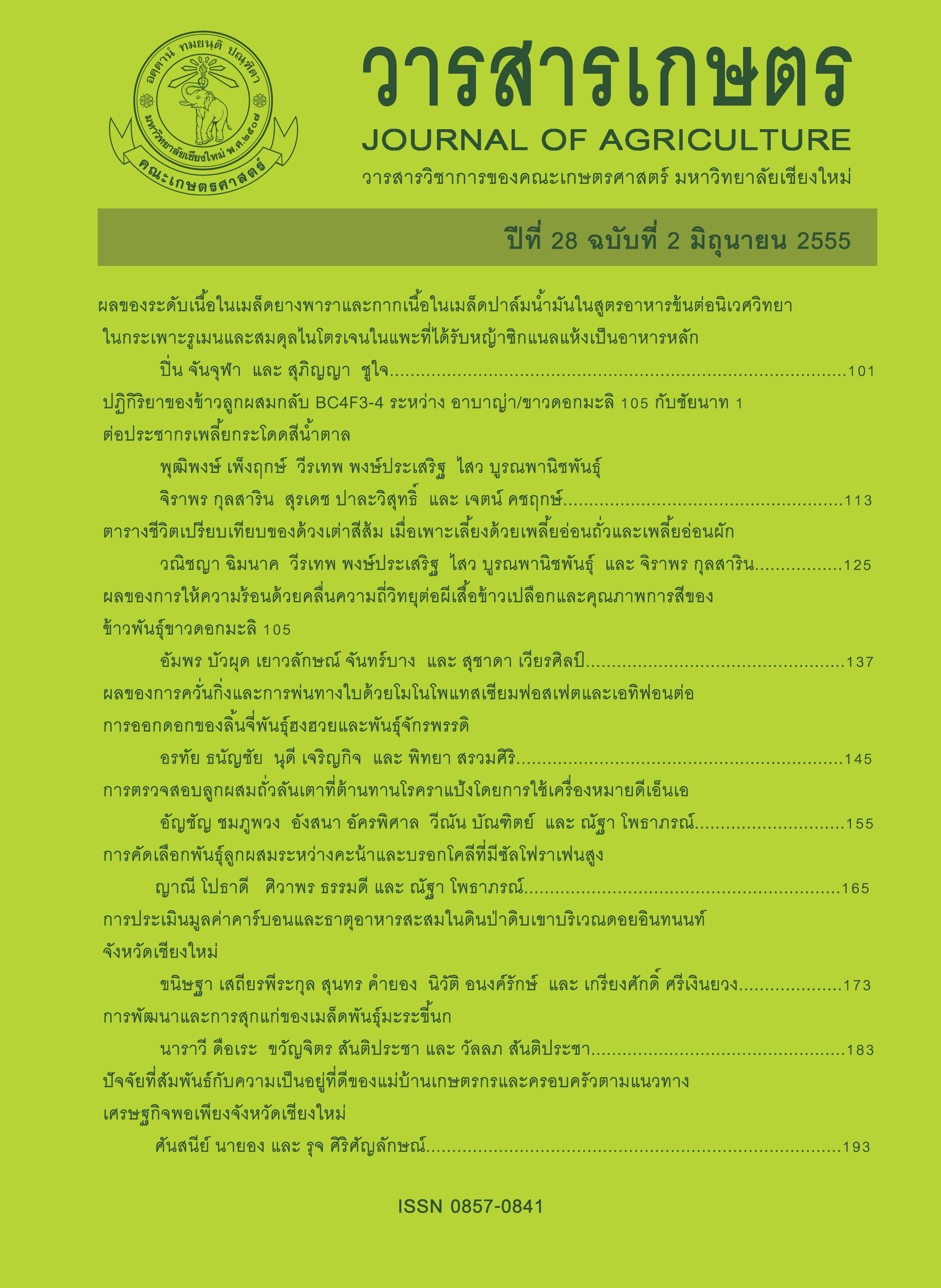ตารางชีวิตเปรียบเทียบของด้วงเต่าสีส้ม เมื่อเพาะเลี้ยงด้วยเพลี้ยอ่อนถั่วและเพลี้ยอ่อนผัก
Main Article Content
บทคัดย่อ
ด้วงเต่าสีส้ม (Micraspis discolor (Fabricius)) (Coleoptera: Coccinellidae) เป็นด้วงเต่าตัวห้ำที่มีบทบาทสำคัญในการควบคุมแมลงศัตรูพืชในนาข้าวและพืชปลูกได้หลายชนิด โดยทั่วไปด้วงเต่าชนิดนี้จัดอยู่ในกลุ่มแมลงตัวห้ำที่กินเหยื่อแบบไม่เจาะจง แต่การเลือกเหยื่อมักเกิดขึ้นเสมอเมื่อมีเหยื่อหลากหลายชนิดอยู่รวมกัน ซึ่งในกระบวนการเพาะเลี้ยงเพิ่มจำนวนนั้นการเลือกเหยื่อที่เหมาะสม นั้นจำเป็นต้องมีข้อมูลพื้นฐานเชิงคุณภาพที่เป็นดัชนีแสดงถึงการเจริญเติบโตของด้วงเต่าได้อย่างเพียงพอ ดังนั้น จึงได้ดำเนินการศึกษาตารางชีวิตของด้วงเต่าสีส้มขึ้นโดยเปรียบเทียบระหว่างการเพาะเลี้ยงด้วยเพลี้ยอ่อนถั่ว (Aphis craccivora Koch) และเพลี้ยอ่อนผัก (Lipaphis erysimi Kaltenbach) ขึ้น เพื่อศึกษาคุณภาพของเพลี้ยอ่อนที่เหมาะสมสำหรับพัฒนาการเพาะเลี้ยงด้วงเต่าสีส้มต่อไป ผลการศึกษาพบว่าระยะการเจริญเติบโตของด้วงเต่าสีส้มเมื่อเลี้ยงด้วยเพลี้ยอ่อนถั่วและเพลี้ยอ่อนผักตั้งแต่ระยะไข่จนถึงตัวเต็มวัย เฉลี่ย 15.24±0.86 และ 14.45±1.06 วัน ตามลำดับ จากตารางชีวิตแบบชีววิทยาด้วงเต่าสีส้มที่เลี้ยงด้วยเพลี้ยอ่อนถั่วมีอัตราการขยายพันธุ์สุทธิ (Ro) เท่ากับ 12.8262 เท่า ค่าสัมประสิทธิ์การเพิ่มทางกรรมพันธุ์ (rc) เท่ากับ 0.1255 เท่า ชั่วอายุขัยของกลุ่ม (Tc) เท่ากับ 20.3385 วันและมีอัตราการเพิ่มที่แท้จริง (l) เท่ากับ 1.1337 เท่า โดยตัวเต็มวัยเริ่มวางไข่ในวันที่ 3 หลังจากเป็นตัวเต็มวัย และวางไข่สูงสุดในวันที่ 6 โดยมีช่วงระยะเวลาวางไข่ 9 วัน ในขณะที่เลี้ยงด้วยเพลี้ยอ่อนผัก มีค่าอัตราการขยายพันธุ์สุทธิ (Ro) เท่ากับ 6.3000 เท่า ค่าสัมประสิทธิ์การเพิ่มทางกรรมพันธุ์ (rc) เท่ากับ 0.1107 เท่า ชั่วอายุขัยของกลุ่ม (Tc) เท่ากับ 16.6190 วันและมีอัตราการเพิ่มที่แท้จริง (l) เท่ากับ 1.1171 เท่า โดยตัวเต็มวัยเริ่มวางไข่ในวันที่ 2 หลังจากเป็นตัวเต็มวัย และวางไข่สูงสุดในวันที่ 3 มีช่วงระยะเวลาวางไข่ 10 วัน จากตารางชีวิตแบบนิเวศวิทยา ด้วงเต่าสีส้มที่เลี้ยงด้วยทั้งเพลี้ยอ่อนถั่วและเพลี้ยอ่อนผักมีอัตราการตายต่อชั่วอายุสูงสุดในระยะตัวอ่อนวัยที่ 1 และมีเส้นกราฟแสดงการรอดชีวิตเป็นแบบ Type II และ Type III ตามลำดับ เพลี้ยอ่อนถั่วจึงมีความเหมาะสมสำหรับการเพาะเลี้ยงด้วงเต่าสีส้ม
Article Details
เอกสารอ้างอิง
จอมสุรางค์ ดวงธิสาร วีรเทพ พงษ์ประเสริฐ ไสว บูรณพานิชพันธุ์ และจิราพร ตยุติวุฒิกุล. 2550. ชีววิทยาและนิเวศวิทยาของด้วงหมัดผักแถบลายในเขตภาคเหนือตอนล่างของประเทศไทย. วิทยาสารกำแพงแสน 5(1): 20-29.
ณัฏฐาวรีย์ กรมศิลป์. 2552. ชีววิทยาของผีเสื้อหนอนกะหล่ำเล็กและแมลงเบียนในพื้นที่ปลูกพืชวงศ์กะหล่ำของมูลนิธิโครงการหลวง. วิทยานิพนธ์วิทยาศาสตรมหาบัณฑิต. มหาวิทยาลัย เชียงใหม่, เชียงใหม่. 62 หน้า.
วิริยา ประจิมพันธุ์. 2550. การศึกษานิเวศวิทยาของแมลงดำหนามมะพร้าว Brontispa longissima Gestro และทดสอบประสิทธิภาพการห้ำของแมลงหางหนีบ Chelisoches morio Fabricius. วิทยานิพนธ์วิทยาศาสตรมหาบัณฑิต. มหาวิทยาลัยเกษตรศาสตร์, กรุงเทพฯ. 117 หน้า.
วีรเทพ พงษ์ประเสริฐ ชุมพณ กันทะ วิภา หอมหวล สิริรัตน์ แสนยงค์ กมลวรรณ โรจน์สุนทรกิตติ และเกียรติศักดิ์ เกิดสุข. 2553. การบริหารโครงการและดำเนินโครงการวิจัยควบคุมศัตรูพืชโดยชีวินทรีย์แห่งชาติ: การควบคุมศัตรูพืชทางการเกษตรโดยชีววิธีของศูนย์ภาคเหนือตอนล่าง. รายงานการวิจัยฉบับสมบูรณ์. สำนักงานคณะกรรมการวิจัยแห่งชาติ, กรุงเทพฯ. 73 หน้า.
อินทวัฒน์ บุรีคำ. 2548. นิเวศวิทยาวิเคราะห์ทางกีฏวิทยา. สำนักพิมพ์มหาวิทยาลัยเกษตรศาสตร์, กรุงเทพฯ. 180 หน้า.
Begum, M.A., M. Jahan, M.N. Bari, M.M. Hossain and N. Afsana. 2002. Potentiality of Micraspis discolor (F.) as a biocontrol agent of Nilaparvata lugens (Stal). J. Bio. Sci. 2(9): 630-632.
Chowdhury, S.P., M.A. Ahad, M.R. Amin and M.S. Hasan. 2008. Biology of ladybird beetle Micraspis discolor (Fab.) (Coccinellidae: Coleoptera). Int. J. Sustain. Crop Prod. 3(3): 39-44.
Deevey, E.S., Jr. 1947. Life tables for natural populations of animals. Quart. Rev. Biol. 22(4): 283-314.
Dixon, A.F.G. 2000. Insect Predator-Prey Dynamics: Ladybird Beetles and Biological Control. Cambridge University Press, Cambridge. 257 p.
Duffieded, S.J. 1995. Crop-specific differences in the seasonal abundance of four major predatory groups on sorghum and short-duration pigeon pea. Intl. Chikpea Pigeon Pea Newsl. 2: 74-76.
Gautam, R.D., S. Chander, V.K. Sharma and R. Singh. 1995. Aphids infesting safflower, their predatory complex and effect on oil content. Ann. Plant Prot. Sci. 3(1): 27-30.
Harmon, J.P., A.R. Ives, J.E. Losey, A.C. Olson and K.S. Rauwald. 2000. Coleomegilla maculata (Coleoptera: Coccinellidae) predation on pea aphids promoted by proximity to dandelions. Oecologia 125(4): 543-548.
Hodek, I. and A. Honek. 1996. Ecology of Coccinellidae. Kluwer Academic Publishers, Dordrecht. 464 p.
Kamal, N.Q., 1998. Brown planthopper (BPH), Nilaparvata lugens Stal situation in Bangladesh. A report of DAE-UNDP/FAO IPM Project, Khamarbari, Farmgate, Dhaka, Bangladesh.
Kawauchi, S. 1991. Selection for highly prolific females in three aphidophagous coccinellids. pp. 177-181. In: L. Polgar, R. J. Chambers, A. F. G. Dixon and I. Hodek (eds.). Behaviour and Impact of Aphidophaga. SPB Acad. Publ., The Hague.
Lakhanpal, G.C. and D. Raj. 1998. Predation potential of coccinellid and syrphid on important aphid species infesting rapeseed in Himachal Pradesh. J. Ent. Res. 22(2): 181-190.
Mani, M. 1995. Studies of natural enemies of wax scale Drepanococcus chiton (Green) on ber and guava. Entomol. 20(2): 55-58.
Milevoj, L. 1997. Effects of food on the adult coccinellids, Coccinella septempunctata L. Zbornik Biotehniske Fakultete Univerze v Ljubljani, Kmetijstvo 69: 137-140.
Obatake, H. and H. Suzuki. 1985. On the isolation and identification of canavanine and ethanolamine contained in the young leaves of black locus, Robinia pseudoacacia, lethal for the lady beetle, Harmonia axyridis. Tech. Bull. Fac. Agr., Kagawa Univ. 36: 107-115.
Okamoto, H. 1966. Three problems of prey specificity of aphidophagous coccinellids. pp. 45-46. In: I. Hodek (ed.). Ecology of Aphidophagous Insects. Academia, Prague & Dr. W. Junk, The Hague.
Olszak, R.W. 1988. Voracity and development of three species of Coccinellidae, preying upon different species of aphids. pp. 47-53. In: E. Niemczyk and A. F. G. Dixon (eds.). Ecology and Effectiveness of Aphidophaga. SPB Acad. Publ., The Hague.
Omkar and S. Srivastava. 2003. Influence of six aphid prey species on development and reproduction of a ladybird beetle, Coccinella septempunctata. BioControl. 48(4): 379-393.
Prabhakar, A.K. and S.P. Roy. 2010. Evaluation of the consumption rates of dominant coccinellid predators on aphids in north-east Bihar. The Bioscan 5(3): 491-493.
Price, P.W. 1997. Insect Ecology. John Wiley and Sons. New York. 874 p.
Prodhan, N.Z.H., M.A. Haque, A.B. Khan and A.K. M. M. Rahman. 1995. Biology of Micraspis discolor (Coleoptera: Coccinellidae) and its susceptibility to two insecticides. Bangladesh J. Entomol. 5: 11-17.
Rao, N.V., A.S. Reddy and K.T. Rao. 1989. Natural enemies of cotton white fly, Bemisia tabaci Gennadius in relation to host population and weather factors. J. Biol. Control. 3(1): 10-12.
Sabchucherdwong, K. 2000. Biological investigation on Bagous subvittatus O’Brien and Morimoto (Coleoptera: Curculionidae) on Hydrilla, Hydrilla verticillata (L.F.) Royle (Hydrocharitaceae). M.S. Thesis. Kasetsart University, Bangkok.
Sakurai, H., N. Yoshida, C. Kobayashi and S. Takeda. 1991. Effects of temperature and day length on oviposition and growth of lady beetle, Coccinella septumpunctata bruckii. Res. Bull. Fac. Agri., Gifu Univ. 56: 45-50.
Shepard, B.M. and H.R. Rapusas, 1989. Life cycle of Micraspis sp. on brown planthopper (BPH) and rice pollen. Int. Rice Res. Newsl. 14: 40.
Southwood, T.R.E. 1978. Ecological methods with particular reference to the study of insect populations. ELBS and Chapman & Hall, Cambridge. 524 p.
Uygun, N. and R. Atlihan. 2000. The effect of temperature on development and fecundity of Scymnus levaillanti. BioControl. 45(4): 453–462.
Visscher, P.K. and R. Dukas. 1997. Survivorship of foraging honey bees. Insectes Sociaux 44(1): 1-5.


